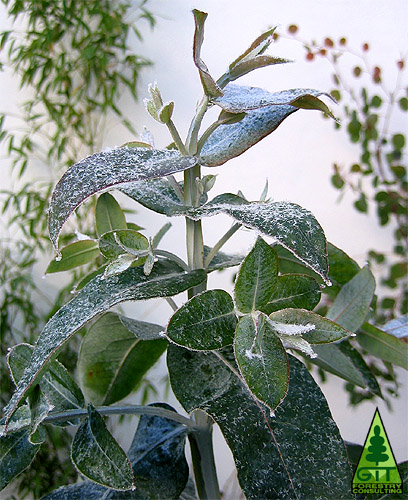 |
||||||||
Eucalyptus globulus. Tasmanian Blue Gum Eucalypt Highland Forests in Northwestern Iberia (II) |
||||||||
Eucalipto globulus. Bosques colinos de Eucalipto Azul de Tasmania en el Noroeste Ibérico (II) |
||||||||
At sea level we started an eucalyptic journey that took us from the foggy coastal belt to 40 kilometers inland following the major representative cultivated forests of this genus in Galicia: Eucalyptus globulus, the Tasmanian Blue Gum tree, capable of producing giant specimens. There in sheltered coastal microclimates we also left other "blue gums" as E. saligna (Sydney Blue Gum) and its close cousin E. grandis (Flooded Gum), too tender except at sea level and unsuitable as we progress in our transect both in elevation (from 0 to 500 meters) and climatic restrictions (from virtually frostless areas to exposed plains, hills and river valleys where minimum temperatures regularly reach -5ºC). Here, E. globulus is pushed to its climatic limit. And some things start to happen. |
||||||||
 |
 |
 |
||||||
Flowering E. globulus below 500 m elevation |
Frozen tender juvenile leaves of E. globulus (-5ºC) |
Frost casualty (will resurrect!) |
||||||
The intrincate topography of Northwestern Iberia permits an interesting variation in microclimatic conditions. Away from the coast and its immediate oceanic influence freezing events and snowfalls are not that rare. Inland plains are exposed to chilly winter winds and fog here, aswell as in the river valleys, is persistant. Hills surrounding the plains also suffer from frost, shade, wind or combinations of these. A bit offsite, E. globulus cultivated here, beyond 400-500 meters above the sea, can survive sometimes. In the mildest parts of this "lowland highland" area frost events can range from 20 to 50 per year. The blue gum trees here get battered every winter and often by several different freezing events around -5ºC. Established trees suffer leaf damage and see their photosynthetic activity severed for next spring. They do not die in the average winter but their growth rate is noticeably reduced. Tender seedlings and young plantations however do suffer average damage resulting in relatively high casualties during the first winters (casualties here are not just dead plants, but also early coppicers with bad form after losing their aerial part during their early life). This makes productive forestry plantations with this species be a very risky option. However, in more frost prone areas (30 to 75 freezing events per year) this situation clearly worsens. In additon, all over this areas "polar winters" do hit every some few years and minimum temperatures can easily drop below -7ºC. When these frost events are of short duration and topographic microclimate collaborate, there is some hope. But when they last for several days, and especially if daylight temperatures do not overpass the freezing point, these Blue Gums are doomed. With relative frequency, minima minimorum of -8 / -11ºC are reached. Definately, too harsh for E. globulus ssp. globulus. |
||||||||
However these climatic restrictions do not mean there is a "non plus ultra" for eucalypt cultivation. It is exactly in these "borderline buffer zones" where proper observation allows finding the first examples of cold hardy Eucalyptus species in cultivation capable of surviving these more restrictive climatic conditions. Be it as isolated specimens, ornamental plantings, small forestry trials or medium to big sized commercial plantations. Not surprising if we consider their growth rates are clearly higher than most of their alternatives for forestry investment (several types of conifers) and that most forestry investors tend to favour as short investment return periods as possible. From here ahead, our journey will follow some 15 additional eucalypt species that are grown in the Iberian Northwest for forestry purposes, stopping at each of them for a while to observe their different adaptative results, silvicultural treatments and timber quality. |
||||||||
 |
||||||||
Eucalyptus species in the Highland Forests of the Iberian Northwest / Eucaliptos en piso colino-montano del Noroeste Ibérico |
||||||||
THE SHINING "BLUE" GUM CULTIVATED FORESTS |
THE ASH GUM TREE CULTIVATED FORESTS : TASMANIAN OAK |
OTHER HIGHLAND EUCALYPTS |
||||||
Eucalyptus delegatensis ssp. delegatensis (E. gigantea) |
||||||||
Eucalyptus denticulata |
Eucalyptus delegatensis ssp. tasmaniensis (E. tasmaniensis) |
Eucalyptus gunnii |
||||||
Eucalyptus cypellocarpa |
Eucalyptus obliqua |
Eucalyptus viminalis |
||||||
Eucalyptus globulus ssp. bicostata (E. bicostata) |
Eucalyptus regnans |
Eucalyptus dalrympleana |
||||||
Eucalyptus globulus ssp. maidenii (E. maidenii) |
Eucalyptus fastigata |
Eucalyptus johnstonii |
||||||
In addition to some work with these already common species GIT Forestry Consulting has started or contributed to the implementation of a series of Eucalyptus trials with some 15 additional species suitable for cultivation in both coastal and highland areas of Northwestern Iberia for different purposes: ornamental plants and forestry species with good potential for several industrial lines. |
||||||||
These are the highland eucalypts, commonly cultivated from 500 to 900 meters elevation in USDA Hardiness Zones 9a (partially), 8b and 8a (partially). But we are not yet done with these ubiquitious Australian trees. Some, very few, grow well beyond 1000 meters elevation, in the "high highlands", where snow and frosts are the routine. These, mostly Snow Gums, are the high mountain Eucalyptus in Northwestern Iberia. And maybe we forgot some other very interesting eucalypts hidden near the Atlantic Ocean. We will be back! |
||||||||
COASTAL EUCALYPTUS FORESTS :: EUCALYPT HIGHLAND FORESTS :: HIGH MOUNTAIN EUCALYPTUS IN IBERIA |
||||||||
 |
||||||||
© 2007 Gustavo Iglesias Trabado / GIT Forestry Consulting - Consultoría y Servicios de Ingeniería Agroforestal |
||||||||